Black-breasted Puffleg
Photo by Roger Ahlman |
|
|
At the forest borders there is also a chance of Rainbow-bearded Thornbill. Other birds to look for are Bar-bellied
and Powerful Woodpecker, Rufous and White-browed Spinetail, Undulated and Rufous Antpitta, White-banded and White-throated Tyrannulet, Crowned Chat-Tyrant, the beautiful Barred Fruiteater, Rufous Wren, Blue-backed Conebill, the local Black-chested Mountain-Tanager as well as Hooded and Buff-breasted Mountain-Tanager, the gorgeous Golden-crowned Tanager, and the rare Páramo Seedeater.After enjoying our box lunches we head to the new road
to Mindo stopping just past the Equator monument to look for White-tailed Shrike-Tyrant and many interandean specialties such as Ash-breasted and Band-tailed Sierra-Finch, Band-tailed Seedeater, Giant Hummingbird, Purple-collared Woodstar and Blue-and-yellow Tanager. We then bird the lower Tandayapa Valley arriving for dinner at Bellavista in a beautiful Cloud
Forest Reserve at 2200m with 700 hectares of protected land and 9 km of trails.
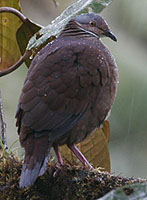
White-throated Quail-Dove
Photo by Boris Herrera
| Tanager Finch
Photo by Janos Olah Jr. |
|
Day 2 In the morning we bird around Bellavista looking for 3 spectacular Chocó endemics; Toucan Barbet, Plate-billed Mountain-Toucan and Tanager Finch (the only spot in Ecuador for this
unique and elusive species), also locating Tanager flocks and return for lunch at the lodge. In the afternoon we visit Tony Nunnery’s house (2000m) for an incredible visual feast of hummingbirds at the feeders including the great Empress Brilliant, Green-tailed Trainbearer and maybe the rare Little Woodstar (up to 24 species in one day have been seen, a world record!) as well as intercepting mixed flocks.
After dusk we shall try for Rufescent Screech-Owl (sometimes split and called Colombian Screech-Owl), Band-winged and Swallow-tailed Nightjar. Rufous-bellied Nighthawk often flies around the Lodge area.  Back to top Back to top 
Day 3 Early morning birding around the lodge and after breakfast we head up to Tandayapa pass (2300m) looking for Ocellated Tapaculo, Beautiful Jay. After lunch we head off to Mindo looking for mixed Tanager flocks which also contain many flycatchers, woodcreepers and
ovenbirds. In particular we'll be on the lookout for Black-chinned Mountain-Tanager, Flame-faced Tanager, Grass-green and Glistening-green Tanager, also Green-and-Black Fruiteater and Crimson-rumped Toucanet. Afternoon visit to Mindo Loma (1800m) for Black-chinned Mountain Tanager and Velvet-purple Coronet among a dazzling array of many
other Tanagers and Hummingbirds. White-throated Quail-Dove sometimes comes in to feed on wheat grains. We then bird the Mindo entrance road arriving for dinner at Septimo Paraiso in a beautiful Cloud Forest Reserve at 1600m with 420 hectares of protected land. 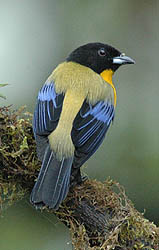
Black-chinned Mountain-Tanager
Photo by Olah Janos
| 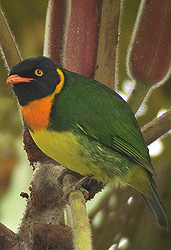
Orange-breasted Fruiteater
Photo by Roger Ahlman
|
|
Day 4
We start at the "hottest" new site, Paz de las Aves, which has been written up in ABA's Birding, Neotropical Birding, as well as by a former client, where Angel Paz has habituated Giant, Yellow-breasted and Moustached Antpittas as well as Dark-backed Wood-Quails. In addition we visit a very active Cock-of-the-Rock lek with up to a dozen extravagant males displaying raucously. Overnight Septimo Paraiso.  Back to top Back to top 
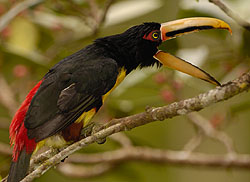
Pale-mandibled Araçari
Photo by Pete Oxford
| 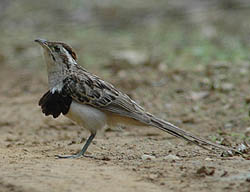
Striped Cuckoo with flared alula
Photo by Janos Olah Jr.
|
|
Day 5
An early start to bird the waterfall trail road above Mindo for Red-headed Barbet, Bay Wren, Crimson-rumped Toucanet and Yellow-faced Grassquit as well as a chance of Orange-crowned Euphonia. Late morning coffee break watching the Hummingbird feeders at Los Colibries Restaurant. Afternoon visit to Milpe road to begin ticking the birds described for day 6. We bird our way leisurely back to the lodge for lunch looking for Golden-headed
Quetzal, Scarlet-backed and Golden-olive Woodpecker as well as Golden-rumped, Orange-bellied and Orange-crowned Euphonia. PM birding around the lodge or out the waterfall road. Overnight same lodge. 
Club-winged Manakin
Photo by Janos Olah Jr.
| 
Hook-billed Kite
Photo by Janos Olah Jr.
|
|
Day 6 We head off downslope starting early at the Milpe road (1100m) for delectibles such as Moss-backed Tanager, great views of exquisite Club-winged Manakins displaying at a lek,
Broad-billed Motmot, Chocó Toucan, Pale-mandibled Araçari, Yellow-collared Chlorophonia as well as Rufous-throated and Glistening-green Tanager. Box Lunch by the River at Puerto Quito (200m) and off to Rio Palenque (220m). After driving many miles through oil palm and banana plantations it's a relief to find ourselves in a Lowland Tropical Rainforest refuge chock-full of birds we haven't seen before such as: Red
-lored Amazon, Bronzy Hermit, Band-tailed Barbthroat, Chestnut-mandibled Toucan, White-tailed Trogon, Barred Puffbird, Red-billed Scythebill along with Tumbesian endemics such as Rufous-headed Chachalaca, Slaty Becard, Ochraceous Attila and Pacific Royal-Flycatcher. Overnight Rio Palenque.  Back to top Back to top
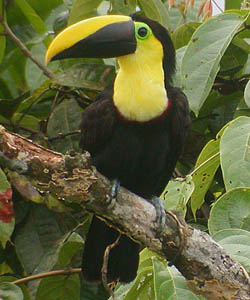
Chocó Toucan
Photo by Roger Ahlman
| 
Male Chocó Trogon
Photo by Roger Ahlman
|
|
Day 7 One of the last remnants of coastal forest, the 167 hectare Río Palenque Scientific Research Center protects 87 ha of tropical rain forest supporting an amazing wealth of biodiversity, including 1,216 plant species, 360 bird species, and 350 butterflies. Gentry (1977) indicates that the "almost 600 species per km 2 recorded from Rio Palenque is
probably the highest recorded plant diversity in the world." This forest was developed as a biological research station in 1970 by the University of Miami, declared a protected area by the Ecuadorian Government in 1971, and acquired by the Wong Foundation in 1998. Due to the small area it has lost 25-30 bird species that require larger forest area such as Harpy Eagle, Great Tinamou and Great Green Macaw, however it remains a remarkably birdy area.
We continue to work the very bird-rich Rio Palenque through lunch looking for Dusky Pigeon, Little Cuckoo, Rufous-tailed Jacamar, Orange-fronted Barbet, Guayaquil Woodpecker, Slaty-winged Foliage-Gleaner, Western Slaty-Antshrike, Pacific Antwren, Sooty -headed and Brown-capped Tyrannulets, Scarlet-browed Tanager and the seasonal Crimson-breasted Finch. Mid afternoon we head off to Pedro Vicente Maldonado with some late afternoon birding before arriving at hotel. 
Ochraceous Attila
Photo by Janos Olah Jr.
| 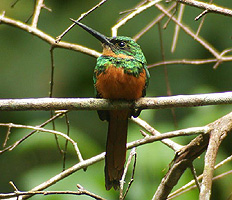
Rufous-tailed Jacamar
Photo by Roger Ahlman
|
|
Day 8
In the morning we bird the Rio Silanche road (AKA Chocó patch at 500m) which is protected by the Mindo Cloud Forest Foundation, for many lowland species and Chocó endemics such as Black-striped Woodcreeper, Yellow-crowned Tyrannulet, Slaty-capped Shrike-Vireo, Chocó Warbler, Scarlet-breasted Dacnis, Emerald, Gray-and-gold, as well as Blue-whiskered Tanagers.
After our box lunch we head to km 106.5 (4 Rivers at 900m) to look for Esmeraldas Antbird, Chocó Trogon, and Checker-throated Antwren. We wind up this week's flurry of birds and drive off to Quito arrivng at the hotel in the early evening. 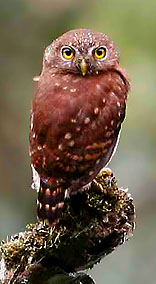
Central American Pygmy-Owl
Photo by Patricio Herrera
| Gray Hawk
Photo by Roger Ahlman |
|
 Back to top Back to top 
Tour Information Price per person: Click here for prices
Included: All lodging, meals, expert bilingual birdguide, transportation, hotel transfer and entrance fees.
Not included: Last night dinner; drinks; tips.
See our Payment and Cancellation Policy page for important information.
|